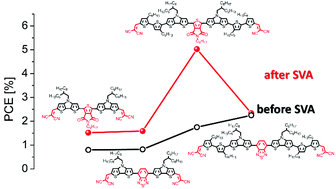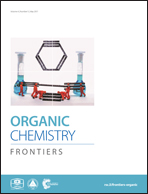The influence of the central acceptor unit on the optoelectronic properties and photovoltaic performance of A–D–A–D–A-type co-oligomers†
Abstract
We present the synthesis and characterization of a series of A–D–A–D–A-type co-oligomers, comprising dithieno[3,2-b:2′,3′-d]pyrrole (DTP) moieties as the electron donor, and thieno[2,3-c]pyrrole-4,6-dione (TPD) or benzo[c][1,2,5]thiadiazole (BTDA) as the central and dicyanovinyl (DCV) groups as the terminal acceptor units. Furthermore, hexylsubstituted bithiophenes were introduced for the elongation of the π-conjugated backbone. The influence of the core acceptor moieties as well as the elongation of the π-system were investigated by UV-vis spectroscopy and cyclic voltammetry. The novel co-oligomers were used as the donor material in solution-processed bulk-heterojunction solar cells (BHJSC) in combination with [6,6]-phenyl-C61-butyric acid methyl ester (PC61BM) as the acceptor. The devices exhibited power conversion efficiencies (PCE) of up to 5.0% after optimization of the photoactive blend layers by solvent vapor annealing (SVA). The influence and effect of the solvent vapor on the photoactive layer was investigated by solid state absorption spectroscopy and grazing-incidence X-ray diffraction (GIXRD) measurements.

- This article is part of the themed collection: Novel π-electron molecular scaffolds


 Please wait while we load your content...
Please wait while we load your content...